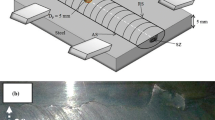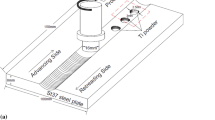Abstract
Friction and wear losses can be reduced by arc welding, tempering and other methods. One of these technologies is vibro-arc surface processing. By using this technology surface can be carbonized through the formation of extra layers with supplementary materials. The present work is an investigation of an opportunity to increase abrasive wear resistance of steel surfaces by carbonizing them by vibro-arc (80 and 120 A current) layering with a graphite electrode and by dip-transfer surfacing welded through layers that create paste-like coatings that consist of materials increasing resistance to wear. The investigations have been performed according to the standards of ASTM G65-94—Dry Sand Rubber Wheel Abrasion Test, and ASTM G132—Standard Test Method for Pin Abrasion Testing. Studies have shown that through surface carbonization layers are produced with a higher wear resistance than surfaces formed with the wear resistant powder PG-10N-01. When using carbonization, the wear resistance of steel surfaces increases by forming austenite synthetic (Fe0.94C0.06), cementite (Fe3C), iron oxide (Fe3.71O4) structures. Even with the wear resistance increased up to 39–41%, the carbonization creates just thin layers of 0.1–0.15 mm. Surface welding with current pulses by using additional materials generates high temperature gradients. This deteriorates coating quality resulting in uneven thickness, formed cracks, voids. The formation of austenite synthetic (Fe0.94C0.06), cementite (Fe3C), chromium nickel (Cr2Ni3), chromium iron carbide (Cr21.34Fe1.66C6), carbon iron (C0.09Fe1.91) structures in a layer increases hardness (average 6145–6310MPa). Although the strengthened layer is much harder than steel Hardox 400, under abrasive wear conditions it has only 20–23% less wear resistance than Hardox 400. Due to surface defects, significant increases in hardness have almost no influence on the wear resistance. Surface quality is increased by welding at a lower current. Because just a thin layer is formed, the carbonization process is not an efficient technology to increase the abrasive wear resistance.
Similar content being viewed by others
References
Amitan, G.L., Baisupov, I.A., Baron, Yu.M., et al., Spravochnik po electrohimicheskim i electrophysicheskim metodam obrabotki (Handbook on Electrochemical and Electrophysical Methods of Machining), Volosatov, V.A., Ed., Leningrad: Mashinostroienie, 1988.
Statsura, V.V., Miheev, A.E., Ivasev, S.S., et al., RF-Patent 2252266, Sposob uprochenia ctal’nyh izdelii (Technique of Strengthening Surfaces of Steel Goods), 2005 (retrieved from: http://www.freepatent.ru/pat-ents/2252266).
ASTM G65-94, Standard Test for Measuring Abrasion Using the Dry Sand/rubber Wheel Apparatus Annual Book of ASTM Standards, vol. 03.02, ASTM, 1996.
ASTM G132-96 (2007), Standard Test Method for Pin Abrasion Testing, West Conshohocken: ASTM International, PA, doi: 10.1520/G0132-96R07, 2007.
Torrance, A.A., Modelling abrasive wear, Wear, 2005, vol. 258, pp. 281–293.
Kolpakov, A.V., Povyshenie iznosostoikosti rabochih organov pochvoobrabatyvayushchih orudii nauglerojivaniem poverhnostnogo sloya (Strengthening of Wear Resistance of Working Elements of Tillage Machines Through Carbonization of the Surface Layer), Extended Abstract of Cand. Tech. Sci. Dissertation, Nizhny Novgorod, 2008.
Hrabě, P., Chotěborský, R., and Medlòn, R., Influence of overlay layers on the abrasive wear, Research in Agricultural Engineering, 2006, vol. 52, no. 3, pp. 115–122.
Stachoviak, G.W. and Batchelor, A.W., Engineering Tribology, Oxford: Elsevier, 2005, 3rd ed.
Jankauskas, V., Kreivaitis, R., Milcius, D., and Baltusnikas, A., Analysis of abrasive wear performance of arc welded hard layers, Wear, 2008, vol. 265, pp. 1926–1932.
Galaev, V.K., Bragin, L.P., and Cafonov, B.P., Vosstanovlenie i uprochenie detalei oborudovania v ucloviyah remontno-mehanicheskogo proizvodstva himicheskogo predpriyatiya (Reconditioning and Strengthening of Machine Components in the Maintenance Shop of a Chemical Plant), Novomoskovsk, 2000.
Author information
Authors and Affiliations
Corresponding author
Additional information
The article is published in the original.
About this article
Cite this article
Jankauskas, V., Skirkus, R. Investigations of abrasive wear of steel surfaces strengthened by vibro-arc carbonization/layering. Surf. Engin. Appl.Electrochem. 49, 396–400 (2013). https://doi.org/10.3103/S1068375513050049
Received:
Accepted:
Published:
Issue Date:
DOI: https://doi.org/10.3103/S1068375513050049




